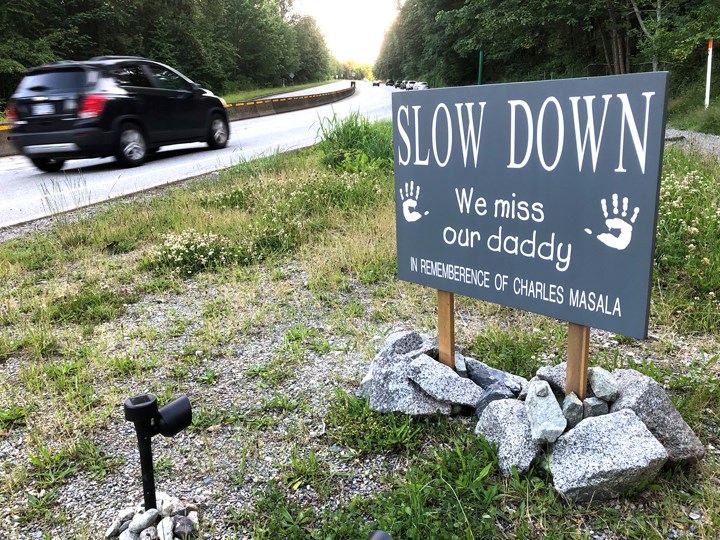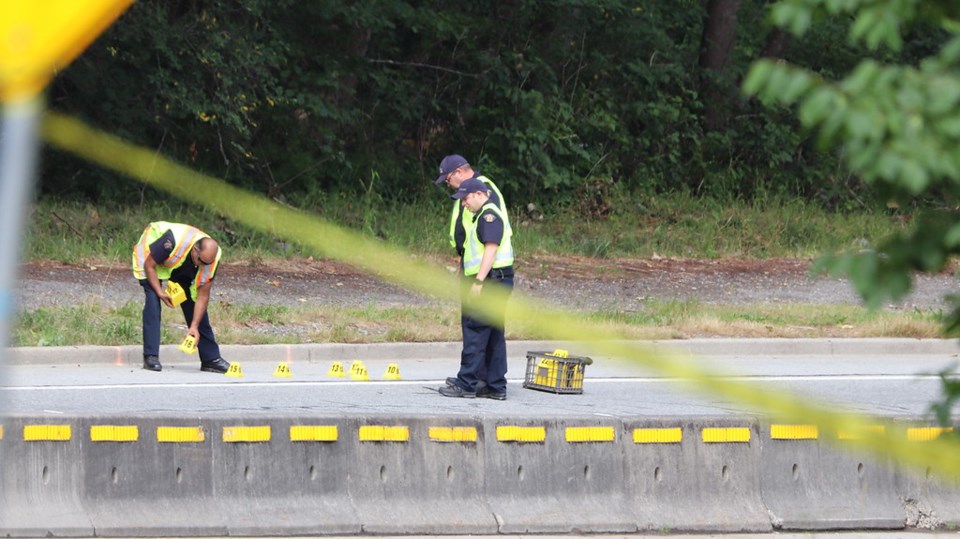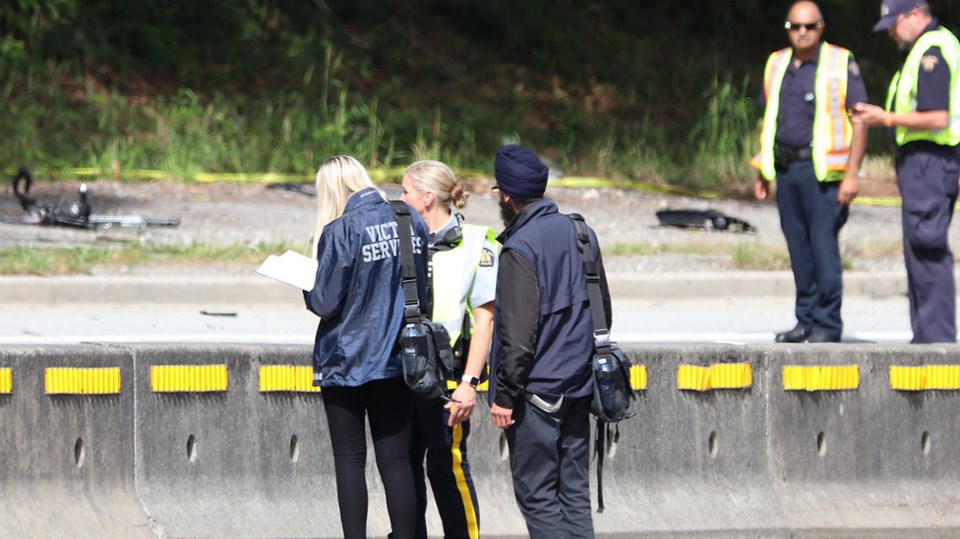It’s been more than a year since a 53-year-old Burnaby father of two jumped on a bike to go for his regular Saturday bike ride and never came back.
Charles Masala died in a hit-and-run on the side of Burnaby Mountain on June 29, 2019.
Standing close to where it happened there’s now a sign urging drivers on Gaglardi Way to slow down.
“We miss our daddy,” the sign reads.

Whoever hit Masala didn’t stay at the scene that day, but police arrested the driver of a black Jeep Cherokee up the hill at University High Street and Tower Road a short time later.
In a press release at the time, they said alcohol might have been a factor in the crash, but, more than a year later, police have yet to lay charges.
Four deadly crashes in one month
When asked about the delay, Burnaby RCMP Cpl. Mike Kalanj said the detachment’s criminal collision investigation team is focusing on “presenting the best possible evidence to the B.C. Prosecution Service for consideration of charges.”
Last year, the criminal collision investigation team, which investigates crashes that lead to serious injury and death, took on 14 investigations, seven of which involved fatalities, Kalanj said.
Four of those deadly incidents happened in June.
Each one is complex, according to Kalanj, with investigators sifting through witness statements, video evidence and forensic analyses of the scene and vehicles involved.
When necessary, police will also apply for warrants and production orders to get their hands on other important evidence, Kalanj said.
The goal, where applicable, is “that the person who was driving at the time of the incident is held accountable for their actions,” he said.
Police won’t comment on Masala’s case specifically.
When asked if there was a suspect, Kalanj pointed back to the original press release, which stated the driver of the black Cherokee had been arrested.
Forensic engineer
If that driver was responsible for Masala’s death, prosecutors may have to connect a lot of dots for a conviction, according to forensic engineer Craig Luker, a court-qualified expert in engineering and accident reconstruction in both civil and criminal matters.
Luker said he’s seen cases involving cyclists where lawyers have started off by arguing the cyclist wasn’t hit by a vehicle at all and simply fell.
Using forensic engineering techniques, however, Luker said investigators can find out whether that’s true by looking for automotive paint on the bicycle, or DNA and bits of clothing from the cyclist on a suspect vehicle.
A crumpled bicycle wheel can offer clues about the height of the bumper that hit it, and bits of a broken grille or reflector at the scene can be matched to a suspect vehicle, Luker said.
“You can find a perfect match on these, and the probability that it was somebody else’s that had the same style of grille or reflector that broke in the same way is pretty, pretty low,” he said.
When reconstructing a collision, Luker said investigators look at three variables: people, vehicles and the environment.

“You look at how these pieces of the puzzle fit together.”
Looking at scuff or skid marks on the road, trails of debris, impacts on the vehicle and more, they can determine what direction the bike and vehicle were going on impact and whether or not the bike had swerved.
As for identifying who was in the driver’s seat, Luker said investigators could dig up photo or video evidence, from dashcams or red light cameras, showing the driver before or after the crash.
The suspect vehicle’s computer technology may also provide clues, he said.
For example, some vehicles’ airbag control modules could corroborate whether or not the weight and height of the person in the driver’s seat at the time of impact roughly matched that of the suspect.
“If they’re unusually small or unusually large, then the airbag control module may corroborate for you that, yeah, it was actually somebody that size who was in the driver’s seat,” Luker said.
Is one year an unusually long time for an investigation?
Luker, who has helped the RCMP with complex investigations “from time to time,” doesn’t think so.
“Certainly with a fatality, the Crown counsel, they don’t want to jump too early,” he said. “They want to make sure that they understand the evidence really well, they have it all really well documented and they’re correct before they charge anybody, so you will find that sometimes in major cases like this there are what feel like very significant delays.”
‘A priority’
Burnaby RCMP said Masala’s case has continued to be a priority for its criminal collision investigation team.
“We are aware of the impact that this has had on the victim’s family and members of the investigative team, and staff from our Victim Services Unit are in regular contact with the family,” the detachment said in a statement.
The NOW has reached out to Masala’s family, but they declined to comment.
“At this time, the family is not prepared to make a statement as the investigation is still ongoing,” read an emailed reply.
Follow Cornelia Naylor on Twitter @CorNaylor
Email [email protected]



